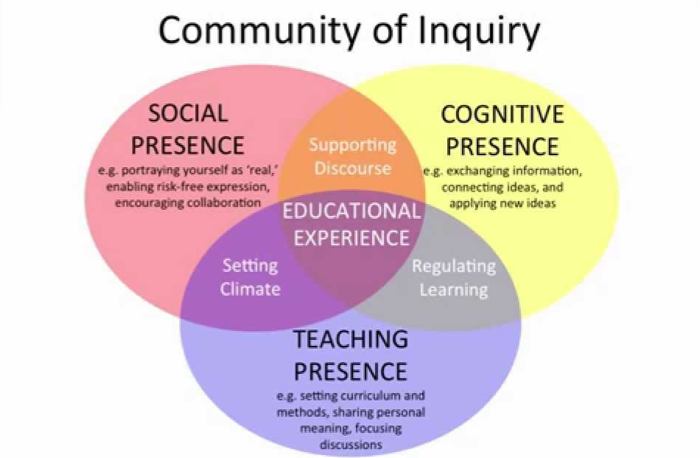
Community of inquiry (Col) helps in designing and delivering online learning groups of individuals are involved in a process of empirical or conceptual inquiry into problematic situations. Col highlights three presences – the social presence, cognitive presence and teaching presence – which has been used a lot in the online learning context where the different presence in the community of inquiry promotes the learning and educational experience of participants. The Col also show to support critical thinking, critical inquiry and discourse among students and teachers (Garrison, et al., 2010)
Social presence is “described as the ability to project one’s self and establish personal and purposeful relationships” (Garrison, 2007, p.3). Three aspects important in the social presence are affective communication, open communication and group cohesion. This type of presence also helps participants to communicate and develop interpersonal relationships while expressing their own diverse personalities. To be able to enhance social presence among students especially in online setting, it is the responsibility of the instructor to create activities that can foster such presence among students. One way to promote social presence is to give task where collaboration is required, where students do not just work with a common goal but work with goals (or projects) that they find relevant to their own self development.
Cognitive presence is ‘the extent to which learners are able to construct and confirm meaning through sustained reflection and discourse in a critical community of inquiry” (Garrison et al., 2000, p. 5). Furthermore, this presence enables students to progressively develop through practical inquiry. This way they do not only problematize practical issues but also seek for a reasonable resolution to such practical issues. This process of understanding the problem, building knowledge, identifying solutions, evaluating solutions, acting on solutions can enhance online collaboration between students where they share information, connect their ideas and also apply new ideas through their interaction.
Teaching presence creates an avenue, set of parameters and a structure for social and cognitive presence to occur. Teaching presence is the design, facilitation and direction of cognitive and social processes for the purpose of realizing personally meaningful and educationally worthwhile learning outcomes (Garrison, et al, 2010). Teaching presence has three aspects to it – Instructional design and organization; facilitating discourse and direct instruction. Where the teaching presence is successful, it enhances students’ satisfaction and sense of community.

Before this course, I have rarely paid attention to the community of inquiry. One reason for this is because before the pandemic, I have only had face-to-face lectures and never really had the need for online learning. The 3 presences in the community of inquiry was mostly designed within the course but not emphasized on how they can individually influence students learning. Taking more lectures online, made it more important for me to look into best ways to appropriately structure my lectures so as to enhance interaction between students. To do this, I have given task where students produce something at the end, usually something tangible. Further, I have ensured that the task is relatable to the current situation and to student’s experiences. In addition, I am explicit and transparent with the course content and information. Here students can easily access information, get clear instructions and have a consistent course structure. Although I have not entirely achieved the “ideal” or “ultimate” educational experience with online learning when applying the Col, it is something that is still in the process of developing.
Garrison, D. R. (2007). Online community of inquiry review: Social, cognitive, and teaching presence issues.Journal of Asynchronous Learning Networks, 11(1), 61–72
Garrison, D. R., Anderson, T., & Archer, W. (2000). Critical inquiry in a text-based environment: Computer conferencing in higher education. The Internet and Higher Education,2, 1–19.
Garrison, D.R., Anderson, T., Archer, W. (2010). The first decade of the community of inquiry framework: A retrospective. The Internet and Higher Education. 13(1), 5-9.